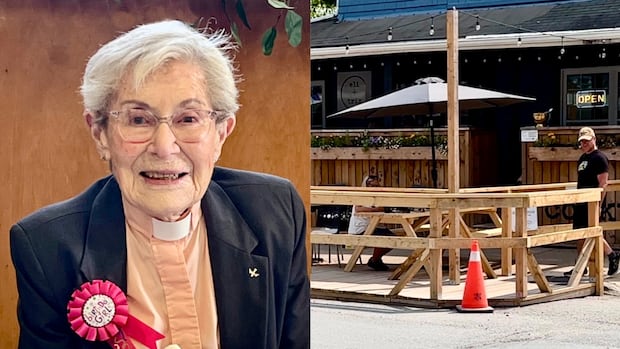Halifax police release use of force policy, three years after request from oversight board

Two years after a confrontation with protesters ended with angry shoving, pepper spray and almost two dozen arrests, Halifax Regional Police finally released its policy on use of force.
It comes as an external review by a Toronto law firm is underway into police action during a protest on Spring Garden Road in August 2021, when hundreds of people tried to stop police and city workers from removing shelters used by homeless people.
After the police used pepper spray and other force to disperse the crowd, critics raised concerns about the police response and some said more could have been done to de-escalate the situation.
The Halifax department previously insisted it could not release the use of force policy, despite direction from its civilian oversight board to post its policies three years ago, an access to information request from CBC News two years ago, and a recommendation from the province’s Information and Privacy Commissioner one year ago calling for its release.
Coun. Becky Kent, chair of the Halifax Board of Police Commissioners, said the time to post the policies was “longer than [the board] wanted.”
“I don’t remember the exact date, but it’s been too long. And so we were really pleased to see that happen,” she said in an interview.
Const. John MacLeod, public information officer for Halifax Regional Police, said the documents are “quite large” and need to be reviewed by the department before release.
“It’s important that they look at those thoroughly to determine if there’s any issues that will arise before they do go out,” he said.
Kent said the civilian board has formed a subcommittee which will review the posted policies to see if they need changes. She said use of force will be one of the first areas to be examined.
“We as a board need to be the champions for the public around accountability, transparency,” she said.
“We saw this as an important piece for the public to understand the policies that are at play.”
Policy written in 1996
The use of force policy was first issued in September 1996 and it has stayed the same since, except for the addition of the section on Tasers in 2011.
“Even though it’s been in existence for quite some time, it certainly is well established and still pertinent today,” MacLeod said of the policy.
MacLeod said a number of policies have been reviewed since 2019, including those covering the canine unit, public safety unit and firearms.

However, the use of force policy is still under review.
‘A huge problem’
Erick Laming is an assistant professor of criminology at Trent University in Peterborough, Ont., and was part of a federally funded, Canada-wide study on police use of force in 2021.
“That’s a huge problem when you’re almost 30 years without a proper overhaul of use of force,” Laming said.
He said in many jurisdictions, officers have to get recertified on use of force annually, and that is often considered the time to do a check or update of policies as needed.

“Maybe nothing needs to be included or amended in that annual update, but at least you’ve reviewed it and you’re doing your due diligence in that sense,” Laming said.
Emphasis on de-escalation
Laming says the Halifax policy doesn’t emphasize “de-escalation” which many other police services have added to their use of force models.
The RCMP announced in 2021 it updated its use of force model to include greater emphasis on communication, crisis intervention, and de-escalation.
De-escalation is discussed in the section of the HRP policy that deals with conducted energy weapons (also called CEWs or Tasers), which is newer than the rest and dates from 2011.
The policy says CEWs should not be used “without due consideration being given to de-escalation or other force options in diffusing the situation.”
There is also some direction given in the older section of the policy, which dates from 1996, that an officer should try to reduce “fear and anger” from any verbal confrontation, and “this will require effective communication skills and patience.”

However, Laming suggested de-escalation often plays a much more prominent role in revised use of force policies.
“In many of these use of force policies that are being updated, de-escalation has become the No. 1 pressure point of, ‘This is what we’re doing with our police now,'” he said.
MacLeod said the principle of de-escalation is part of the “broader overall approach” of the police policy.
“The guiding principles are for us to use as little force as reasonably necessary,” MacLeod said. He said officers are trained in the importance of de-escalation.
“If we can conclude a situation safely, without using force, that’s going to be our goal,” he said.
Amount of force depends on situation
Laming emphasized that “flexibility” and “nuance” are always contained in police use of force policies, as each situation is unique and relies on the officer’s perceptions of how much force to use.
“In a majority of cases, some level of physical force will be necessary to effect an arrest or to protect others,” the HRP policy states, explaining that the amount of force depends on the level and type of resistance offered by the subject.
The HRP policy considers resistance ranges from things like ignoring police orders, to “passive resistance” such as a person going limp on the ground, to active aggression such as when a subject tries to strike an officer.
“It’s always about the reasonableness of the officer in those situations,” Laming said.
Documents released after years
In August 2020, the Halifax board of police commissioners voted to direct the police to post its policies online, and specifically named the use of force policy.

Yet, by the time the homelessness protest happened in August 2021, the policy had not been posted. The CBC placed an access to information request with the police to see the use of force policy. The police denied this request in full and CBC appealed the decision to the provincial information and privacy commissioner.
In July 2022, the commissioner issued a decision that criticized the police’s decision to withhold the information and recommended it be released. HRP did not do so at that time, and is recorded as not accepting the recommendations.
But, in July 2023 the HRP released 270 pages of documents about the shelter removals to CBC, including the use of force policy. A few weeks after it was released to CBC, HRP posted the policy online.
‘Very significant’ release
Information and Privacy Commissioner Tricia Ralph told CBC in an interview in July she welcomed the release of information, even a year after her recommendation.

“That’s very significant. That’s what we like to see,” she said. However, she said the law requires strict timelines for a response that weren’t met in this case.
“We often say in the access and freedom of information world that access delayed is access denied,” Ralph said.
“What we mean by that is, timely access to information is important and that’s reflected in the legislation that requires such short timelines.”



